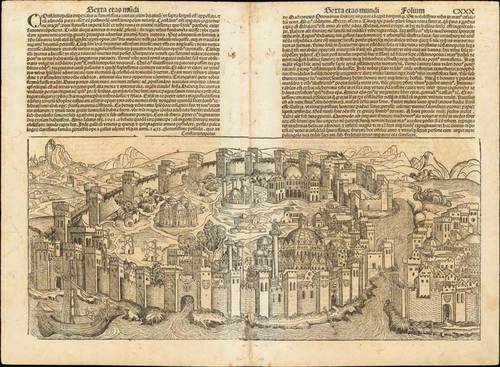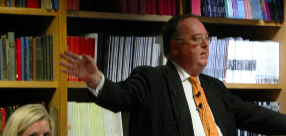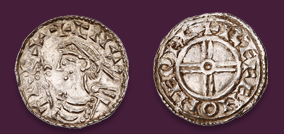
Auction: 15040 - Antique Maps sale during the International Exhibition
Lot: 164
Maps
Middle East
Constantinople
1493 Serta Etas Mundi (Nuremberg Chronicle), folio CXXX by Anton Koberger; 23 x 16¾ inches, uncoloured.
Two sheets of incunabula with original woodcut engravings on the front and on the reverse. At the top of the cards CXXIX / to and CXXX / recto text in Gothic characters and in Latin; in the bottom half of the same facciateampia view of Constantinople in woodcut; on the other two façades, gothic text in Latin, accompanied by 7 beautiful silografate cartoons with images of the Empress Helena, the fathers of the Council of Nicaea, heresiarch Arius and four emperors. The sheets are taken from a famous incunabula, imprinted in Nuremberg in 1493 in the original text with Latin: in the same year they released the impression with text in German, translated by Georg Alt. The fame of the book is mainly linked to the accompanying illustrative over two thousand woodcuts, some of which belong to the young Dürer. The magnificent view of Constantinople, as representations of other cities in the volume, combines conventional elements of fantasy and other topographic features with reference to reality. The image is placed in evidence, with a caption, the church of Santa Sofia; interesting is the depiction of a ship in the lower sinstra.
Tape reinforcement to the central fold and there is some light ageing as to be expected, otherwise is a good state of preservation. Photo
This page was removed from a book entitled Liber Chronicarum, or 'Nuremberg Chronicle', published in 1493 by printer Anton Koberger. One of the most ambitious books produced in the 15th century with over 1000 woodcut illustrations, the 'Nuremberg Chronicle' was also one of the earliest books with illustrations designed by artists rather than blockcutters. Koberger commissioned Michael Wolgemut, who ran a large art workshop, to design the illustrations and layout between 1487 and 1491. Wolgemut was helped by his stepson Wilhelm Pleydenwurff
Woodcut images could be printed on the same page as text because the type used to print the words and the woodcut image were both in relief, so they could be set together in the same frame (called a ‘forme’) and printed simultaneously.
In common with practice at the time, not all of the images in the Chronicle were original designs, some being copies after artists like Martin Schongauer, and some being used more than once in the same book. But where earlier woodcut book illustrations were simple outlines the use of light and tone shows how differently an artist responded to the potential of the woodcut medium. Books like this led to artists such as Albrecht Dürer considering the potential of the woodcut as a medium of expression. Dürer trained under Wolgemut between 1486 and 1489 at around the time when Wolgemut received the commission for this book.
Estimate
SG$200 to SG$250
Sale 15040 Notices
Estimate restated to S$600-700




